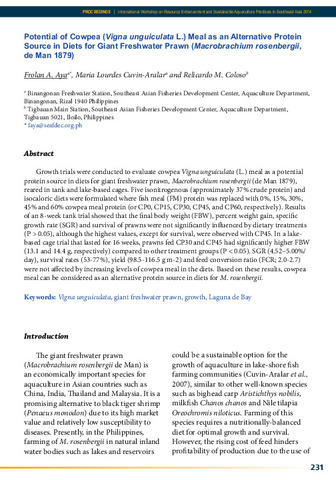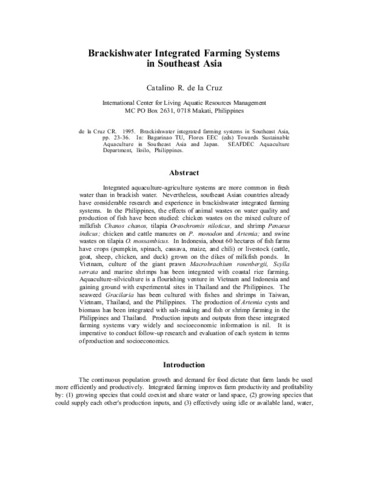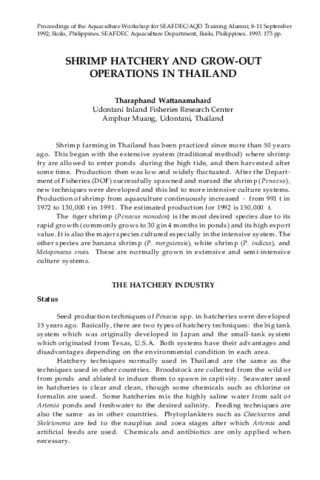Potential of cowpea (Vigna unguiculata L.) meal as an alternative protein source in diets for giant freshwater prawn (Macrobrachium rosenbergii, de Man 1879)
- Global styles
- MLA
- Vancouver
- Elsevier - Harvard
- APA
- Help
Share
Abstract
Growth trials were conducted to evaluate cowpea Vigna unguiculata (L.) meal as a potential protein source in diets for giant freshwater prawn, Macrobrachium rosenbergii (de Man 1879), reared in tank and lake-based cages. Five isonitrogenous (approximately 37% crude protein) and isocaloric diets were formulated where fish meal (FM) protein was replaced with 0%, 15%, 30%, 45% and 60% cowpea meal protein (or CP0, CP15, CP30, CP45, and CP60, respectively). Results of an 8-week tank trial showed that the final body weight (FBW), percent weight gain, specific growth rate (SGR) and survival of prawns were not significantly influenced by dietary treatments (P > 0.05), although the highest values, except for survival, were observed with CP45. In a lakebased cage trial that lasted for 16 weeks, prawns fed CP30 and CP45 had significantly higher FBW (13.1 and 14.4 g, respectively) compared to other treatment groups (P < 0.05). SGR (4.52 5.00%/ day), survival rates (53-77%), yield (98.5-116.5 g m-2) and feed conversion ratio (FCR; 2.0-2.7) were not affected by increasing levels of cowpea meal in the diets. Based on these results, cowpea meal can be considered as an alternative protein source in diets for M. rosenbergii.
Suggested Citation
Aya, F. A., Cuvin-Aralar, M. L., &Coloso, R. M. (2015). Potential of cowpea (Vigna unguiculata L.) meal as an alternative protein source in diets for giant freshwater prawn (Macrobrachium rosenbergii, de Man 1879). In M. R. R. Romana-Eguia, F. D. Parado-Estepa, N. D. Salayo, &M. J. H. Lebata-Ramos (Eds.), Resource Enhancement and Sustainable Aquaculture Practices in Southeast Asia: Challenges in Responsible Production of Aquatic Species: Proceedings of the International Workshop on Resource Enhancement and Sustainable Aquaculture Practices in Southeast Asia 2014 (RESA) (pp. 231-237). Tigbauan, Iloilo, Philippines: Aquaculture Department, Southeast Asian Fisheries Development Center.
Type
Conference paperISBN
9789719931041
Related items
Showing items related by title, author, creator and subject.
-
Shrimp grow-out culture techniques in the Philippines
Gicos, Apolinario (Aquaculture Department, Southeast Asian Fisheries Development Center, 1993)The major commercial shrimp species in the Philippines belong to the genus Penaeus and Metapenaeus. The important penaeid shrimps are: P. monodon (giant tiger shrimp or sugpo); P. japonicus and P. semisulcatus (tiger shrimp ... -
Brackishwater integrated farming systems in Southeast Asia
De la Cruz, Catalino R. (Aquaculture Department, Southeast Asian Fisheries Development Center, 1995)Integrated aquaculture-agriculture systems are more common in fresh water than in brackish water. Nevertheless, southeast Asian countries already have considerable research and experience in brackishwater integrated farming ... -
Shrimp hatchery and grow-out operations in Thailand
Wattanamahard, Tharaphand (Aquaculture Department, Southeast Asian Fisheries Development Center, 1993)Shrimp farming in Thailand has been practiced since more than 50 years ago. This began with the extensive system (traditional method) where shrimp fry are allowed to enter ponds during the high tide, and then harvested ...







